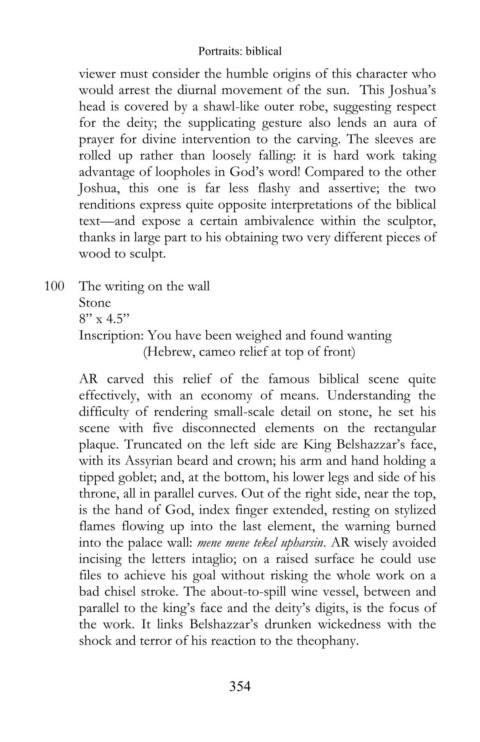Page 358 - The Legacy of Abraham Rothstein - text
P. 358
Portraits: biblical
viewer must consider the humble origins of this character who
would arrest the diurnal movement of the sun. This Joshua’s
head is covered by a shawl-like outer robe, suggesting respect
for the deity; the supplicating gesture also lends an aura of
prayer for divine intervention to the carving. The sleeves are
rolled up rather than loosely falling: it is hard work taking
advantage of loopholes in God’s word! Compared to the other
Joshua, this one is far less flashy and assertive; the two
renditions express quite opposite interpretations of the biblical
text—and expose a certain ambivalence within the sculptor,
thanks in large part to his obtaining two very different pieces of
wood to sculpt.
100 The writing on the wall
Stone
8” x 4.5”
Inscription: You have been weighed and found wanting
(Hebrew, cameo relief at top of front)
AR carved this relief of the famous biblical scene quite
effectively, with an economy of means. Understanding the
difficulty of rendering small-scale detail on stone, he set his
scene with five disconnected elements on the rectangular
plaque. Truncated on the left side are King Belshazzar’s face,
with its Assyrian beard and crown; his arm and hand holding a
tipped goblet; and, at the bottom, his lower legs and side of his
throne, all in parallel curves. Out of the right side, near the top,
is the hand of God, index finger extended, resting on stylized
flames flowing up into the last element, the warning burned
into the palace wall: mene mene tekel upharsin. AR wisely avoided
incising the letters intaglio; on a raised surface he could use
files to achieve his goal without risking the whole work on a
bad chisel stroke. The about-to-spill wine vessel, between and
parallel to the king’s face and the deity’s digits, is the focus of
the work. It links Belshazzar’s drunken wickedness with the
shock and terror of his reaction to the theophany.
354

